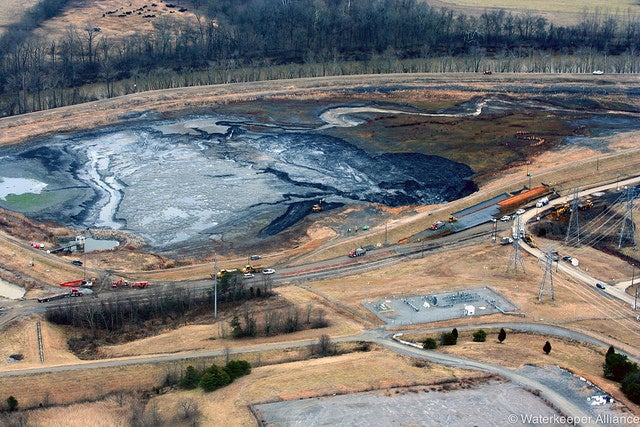
This recent spill on the Dan River in North Carolina dumped thousands of tons of toxic coal ash into a river.
News and commentary on hurricanes, DACA, the debt limit and other timely topics have eclipsed a few recent incidents that deserve comment. One is Donald Trump’s continuing description of coal as “beautiful” and “clean.”
To prove his point during a recent campaign rally, Trump mentioned a new coal mine in Pennsylvania. “They’re taking out coal,” he told the crowd. “They’re going to clean it.” Back in June he said “You see what’s happening with coal. Coal is coming – clean coal. We love clean coal and it’s coming back.”
But although the coal industry has good days and bad days, coal does not have a future in our energy mix. One reason is that Trump’s repeated description of coal as “clean” is flatly untrue. We need to put it to rest. Toward that end, this post is a brief description of the life cycle of this dirtiest of fossil fuels.
“Beautiful” coal: OK, in one way of looking at it Trump is correct that coal is beautiful. It is a remarkable rock. It is the energy of the sun stored in plants that lived millions of years ago, died and then were subjected to pressure under the Earth. Pick up a lump and you’re holding once-living biota and millions of years of the Earth’s history in your hand. Leave coal deep underground with the right mixture of heat and pressure for a few billion years and that rock in your hand becomes a diamond.
Coal is widely used around the world because, unlike oil and natural gas, it is available in most regions. It is cheap and it contains impressive amounts of latent energy. The United States has the world’s second-largest coal deposits, enough according to the U.S. Department of Energy to provide energy for the next 200 to 300 years — an estimate that is widely disputed as being far too high. But where coal deposits are located and how much is left is not important anymore. The limiting factor is not how much is in the ground; it’s how much pollution we can safely put into the sky. The correct answer is none.
The scientific evidence that carbon dioxide is emitted when coal is combusted is a very important reason to retire coal use, but there are many others. Coal could be called Pandora’s Rock. From the moment we open the earth to get it, we unleash a chain of harmful impacts on public health and safety, air and water quality, and freshwater supplies. We know from credible scientists and defense experts that coal pollution helps trigger climate change and that climate change threatens national security.
The reality is that the only clean coal is the stuff that remains deep underground. Even if we were able to scrub out the carbon dioxide when coal is burned, it creates serious problems through the other parts of its life cycle. Simply put, the words “clean” and “coal” are an irresolvable oxymoron when they are used together.
Here are some details that Trump should know:
Extraction: Coal is extracted by surface as well as sub-surface mining. We’ve all seen pictures of strip mines where landscapes and soils have been pushed aside to expose coal seams. One of the most destructive forms of surface mining is the decapitation of mountains in Appalachia. Blasting exposes coal seams so that they can be mined by enormous machines rather than by men and women.
“Mountain top removal”, as the process is known, produces dirt and rock rubble that coal companies call “overburden”. Mining companies typically dump the rubble into nearby valleys. Researchers at Duke University estimated that by 2016, the refuse from mining had been dumped into 1,544 valleys in southern West Virginia alone. Appalachian Voices, a local environmental organization, reports that more than 2,000 miles of headwater streams have been buried by mining rubble. EPA studies show that the debris degrades water quality and kills aquatic life.
Washing. This may be where Trump goes wrong. Raw coal is taken to “wash plants” for a water-intensive process that cleans out its noncombustible contents – soil, rock and the like. However, washing does not remove toxins and pollutants that coal releases when it is burned, including carbon dioxide, sulfur dioxide, nitrogen oxides, particulate matter, mercury and other heavy metals. In January 2014, 7,500 gallons of a chemical used to wash coal leaked from a coal processing plant into West Virginia’s Elk River in West Virginia, then into other rivers. As many as 300,000 people in the Charleston metropolitan area were left without drinking water.
Blackwater. During processing, coal is crushed and combined with water so it can be pumped and moved through pipelines. One byproduct is “blackwater”, a waste that consists of water and fine coal particles. Another waste product is called coal sludge or slurry, a mixture of wastewater and solid mining refuse. Both of these wastes are usually put into large impoundments or “ponds”, typically located in valleys dammed with solid mining refuse.
A study for the federal Office of Surface Mining Reclamation and Enforcement found in 2011 that many of these man-made ponds are dangerous because of poor construction. In fact, there have been several incidents in recent years where impoundments have failed and slurry has escaped into rivers and towns. An estimated 306 million gallons of grey sludge found its way into a coal mine in Martin County, Kentucky, in 2000 and leaked into the Ohio and Big Sandy Rivers. The release was 30 times larger than the Exxon Valdez oil spill. It contaminated the water supply for more than 27,000 people.
Combustion: Coal is composed mostly of carbon and hydrocarbons, but it also contains hydrogen, sulfur, oxygen, sulfur, ash, chlorine and sodium. As I pointed out earlier, combustion releases a variety of pollutants known to be detrimental to human health including particulate matter, sulfur dioxide and nitrogen dioxide. Because of that, the Clean Air Act requires that emissions of these pollutants be regulated by the Environmental Protection Agency (EPA). Coal combustion is also the principal source of mercury emissions, also regulated by EPA because they can impair neurological development in fetuses, infants and children.
Coal Ash: Combustion results in more than a hundred million tons a year of coal ash in the United States. It is our second largest waste stream. Coal ash is a combination of fine particles called fly ash and coarser materials that fall to the bottom of the power plant’s furnace. The ash contains a range of metals called “residuals” that include arsenic, selenium and cadmium.
Some coal ash is used in concrete cement and other useful materials, but much of it is stored in “ash ponds”, landfills and other disposal sites. The environmental organization Earth Justice counts more than 1,400 coal ash waste dumps around the country, with more than 200 known cases of water contamination and more than 330 ponds rated as high or significant hazards.
In Tennessee nine years ago, the dam on a pond holding more than 1 billion gallons of coal ash failed and released 5.4 million cubic yards of toxic sludge that covered 12 homes and damaged 42 residential properties. In 2014, a broken pipe sent an estimated 82,000 gallons of coal ash into the Dan River in North Carolina.
In 2014, EPA proposed the first national regulation of coal ash, including requirements that ponds and landfills be monitored and properly maintained. With the Trump Administration now in charge of EPA, a group representing electric utilities and major industry associations has petitioned the agency not to enforce the rule. Trump’s EPA reportedly wants states to establish their own ash disposal program – a move environmental groups say will weaken the rule because many coal states have poor records for enforcing regulations on coal companies.
Carbon capture and sequestration (CCS): Although CO2 emissions from power plants are one of the principal causes of anthropogenic climate change, there are no limits on the amount of the gas that power plants can emit. In the context of climate change, the coal industry’s claim to “clean” depends on the development and commercialization of Carbon Capture and Sequestration (CCS), a process that traps CO2 at power plants and factories before it can enter the air, then buries it underground. But after 20 years of research, billions of dollars of taxpayer investment and multiple failures of pilot projects, CCS still is not ready for commercial use. CCS requires bigger power plants, more water consumption and higher energy bills at the same time the costs of renewable fuels like solar and wind are rapidly falling.
***
Since 1882 when it was first used to generate electricity in the United States, coal has been the energy star of industrialization. What we know now, however, is that coal has become too much of a good thing. Coal emits more climate-changing CO2 than any other fossil fuel.
With much cleaner and more affordable alternatives available for producing electricity today, and with a concerted national effort to use them, we would not have to live with the consequences of coal. With a massive effort to help developing nations get their electricity from carbon-free renewable resources, the rest of the world would not need coal, either.
It’s true that no known energy resource is perfectly clean. Solar panels and wind turbines require the use of chemicals during manufacturing. But once in operation, these technologies produce free energy safely, without pollution and without wastes.
What Trump needs to know is that we no longer need to dig, blast, dump and pollute to keep our lights lit in the 21st century. If we want clean and beautiful energy, carbon-free renewable resources are where we’ll find it.
